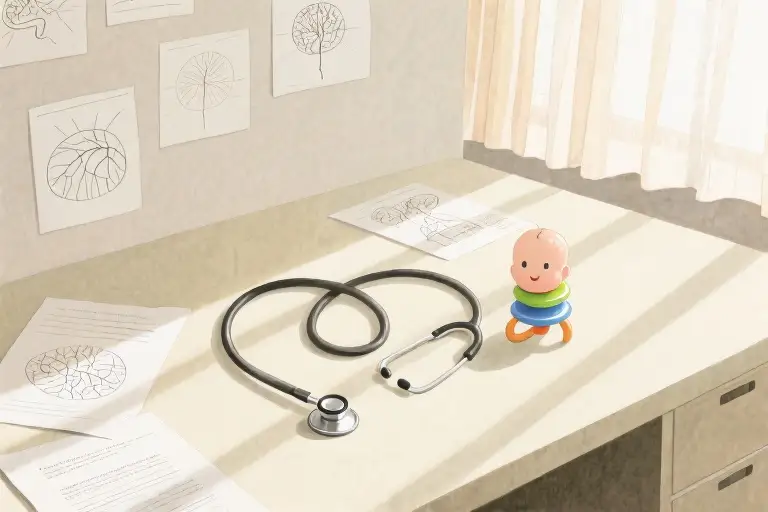The stage lights at the Neuroscience Symposium in Berlin still burn behind my eyelids – that moment when 300 academics leaned forward as I explained synaptic pruning patterns. My pointer moving across brain scan projections, the weight of my doctoral hood on my shoulders, the crisp click of my laser pen marking key findings. Just eighteen months ago, this was my definition of productivity: peer-reviewed publications, keynote invitations, marathon finish lines crossed before breakfast.
My CV bullet points read like a productivity manual:
- PhD summa cum laude in cognitive linguistics
- 7 first-author publications before age 30
- Fluent in 4 languages with 2 more in progress
- TEDx talk on language acquisition viewed 250K times
- Ultramarathon finisher’s medal from Patagonia
Now my metrics have shifted. The glowing numbers on my nightstand clock read 3:17am as I rock in the nursing chair, measuring output in milliliters of breastmilk rather than impact factors. My research notes have been replaced by diaper change logs tracking color and consistency. That laser pointer? Repurposed to entertain a four-year-old making shadow puppets on the nursery wall.
I am…
This seismic shift from academic excellence to maternal caregiving forced me to confront a fundamental question: When burp cloths replace data sheets and lullabies override lecture notes, what does true productivity become? The cognitive dissonance between my before and after lives reveals deeper truths about how we measure worth in a society obsessed with visible achievement.
As a neuroscientist, I recognize this transition as more than lifestyle change – it’s neural rewiring. The same prefrontal cortex that once synthesized complex research data now calculates nap window probabilities. My hippocampus, formerly storing conference presentation details, has become a catalog of pediatrician phone numbers and immunization schedules. Yet in this unexpected transformation, I’m discovering an unorthodox laboratory where parenting becomes the ultimate cognitive science experiment.
Three sleep-deprived months into maternity leave, I caught myself analyzing my baby’s vocalizations with the same intensity I once applied to phoneme pattern research. The realization struck: perhaps my academic training didn’t end with my PhD defense – it simply entered its most fascinating field study yet. This perspective shift didn’t erase the struggle (the mountain of unfinished grant applications on my desk confirms that), but it revealed an unexpected continuity between my identities as researcher and mother.
In the quiet chaos of 4am feedings, I’ve begun compiling mental field notes on this strange new productivity paradigm:
- Micro-moments matter – Fifteen seconds of eye contact during diaper changes stimulate more neural development than any conference Q&A session I’ve conducted
- Presence over publications – Tracking my daughter’s language acquisition day-by-day provides richer data than any longitudinal study I’ve published
- The myth of multitasking – Juggling babywearing with email responses creates cognitive load that diminishes both caregiving quality and work output
My laboratory has expanded beyond university walls to include onesie-changing stations and playground sandboxes. The peer review process now happens during playdates with other scientist-parents comparing sleep training methodologies. And surprisingly, my academic skills translate in unexpected ways – literature review techniques help me evaluate parenting studies, my statistical training allows me to parse vaccine efficacy data, and years of conference networking prepared me for the complex social dynamics of mom groups.
Yet this transition remains profoundly disorienting. There are days when I stare at my half-written journal article and mourn my former productivity. Nights when I question whether changing the fifteenth diaper of the day constitutes meaningful work. Moments when my daughter’s tantrums make me doubt if my PhD conferred any practical life skills at all.
But then comes the breakthrough – like when my toddler used her first German compound noun (“Regenbogenstiefel” for rainbow boots) proving our bilingual experiment works, or when I discovered rocking my son to sleep provided the mental space to solve a research problem that had stumped me for weeks. These small victories reveal an uncomfortable truth: perhaps we’ve been measuring productivity all wrong.
I am…
(becoming someone who measures output in giggles elicited and curiosity nurtured rather than citations accrued. Learning that cognitive labor includes the invisible mental load of remembering which stuffed animal is currently favored. Discovering that true efficiency means sometimes leaving emails unanswered to build block towers that will inevitably topple.)
This is the paradox of academic motherhood – the skills we honed chasing scholarly achievement become unexpectedly relevant in raising tiny humans, while simultaneously feeling inadequate for the emotional and logistical demands of caregiving. The solution isn’t choosing between identities, but recognizing how each reshapes and informs the other in unexpected ways.
As the first light filters through the nursery curtains, my son’s tiny hand grips my finger with surprising strength. Somewhere in this sleep-deprived haze between data analysis and diaper duty, between faculty meetings and first words, I’m discovering a new definition of productivity – one that values neural connections over professional networking, presence over publications, and the courage to say “I am…” without needing to complete the sentence with traditional measures of success.
Cognitive Earthquake: When Academic Thinking Meets Infant Needs
The first seismic shift came when I opened my meticulously organized lab notebook next to my newborn’s feeding log. Where chemical formulas and statistical models once lived, now sprawled erratic entries: “3:15am – 7min left breast, spit-up incident, diaper change #4.” My beloved color-coded system had devolved into survival scrawls.
The Great Methodology Clash
As neuroscientists, we’re trained to control variables. Yet here I was, attempting to “replicate findings” with an unpredictable little human whose protocol changed daily. The controlled environment of my PhD research – with its standardized procedures and replicable results – felt galaxies away from the beautiful chaos of parenting.
Scene 1: Lab Notebook vs Baby Log
- Before: Peer-reviewed precision with p-values and confidence intervals
- After: Subjective observations (“seems fussier when wearing striped onesies”)
- Cognitive dissonance: My academic training screamed for controlled conditions while motherhood demanded radical adaptability
Social Script Rewrites
The second tremor hit during my first mom-group meeting. Gone were the conference coffee breaks debating recent publications. Instead, we traded war stories about diaper blowouts and sleep regressions with the intensity of lab meeting problem-solving sessions.
Scene 2: Academic Networking vs Mom Tribe
- Before: Elevator pitches about my research gap
- After: Urgent consultations about nipple confusion
- Hidden similarity: Both required quickly identifying who held relevant expertise – just with different credential systems
Deadline Dissonance
Then came the vaccine schedule. My Google Calendar, once ruled by grant deadlines and conference abstract submissions, now pulsed with pediatric appointments. The irony wasn’t lost on me – I’d studied circadian rhythms for years, yet nothing prepared me for the brutal time calculus of newborn care.
Scene 3: Academic Calendar vs Well-Baby Visits
- Before: Carefully planned manuscript submission timeline
- After: Survival mode between 2-week growth checks
- Epiphany: Both systems valued timely interventions, just operating on different biological clocks
The Fifth Feeding Revelation
At 3:17am during my fifth failed attempt to nurse, something shifted. As I watched moonlight trace the same path across the nursery wall it had for weeks, my researcher brain unexpectedly activated. This wasn’t data noise – these were longitudinal observations revealing patterns invisible in single sessions. The very skills that made me analyze neural pathways were helping me decode my baby’s cues.
Scientific Parenting Insight:
What initially felt like lost productivity was actually observational research at its purest – continuous data collection without premature conclusions. My academic training hadn’t deserted me; it had simply found a new application domain.
Cognitive Load Management
Key strategies that emerged:
- Variable Acceptance: Treating each day as a new experimental condition rather than failed replication
- Pattern Detection: Identifying micro-rhythms amidst apparent chaos
- Meta-Observation: Noticing how my own neural pathways were rewiring through the process
This cognitive earthquake didn’t destroy my academic identity – it revealed its unexpected elasticity. The same neural plasticity I’d studied in the lab was now reshaping my own brain, forging connections between seemingly incompatible worlds.
The Academic Mom’s Toolkit: When Research Skills Meet Parenting
Five months into my second maternity leave, I found myself staring at 37 open browser tabs comparing sleep training methods. The irony wasn’t lost on me – this was precisely how I’d conducted literature reviews for my neuroscience PhD. That’s when I realized: my academic training wasn’t obsolete; it just needed repurposing.
Methodology #1: Systematic Review for Parenting Theories
Parenting advice floods our inboxes like unmoderated conference submissions. My solution? Apply the same rigorous screening process I used for academic papers:
flowchart TD
A[Initial Search: 200+ methods] --> B[Inclusion Criteria:
- Peer-reviewed studies
- Longitudinal data
- Replication studies]
B --> C[15 qualified sources]
C --> D[Critical Appraisal:
- Effect sizes
- Control groups
- Funding sources]
D --> E[3 evidence-based techniques]This scientific parenting approach saved me from analysis paralysis. When the “100 Days of Baby Boot Camp” program promised to make infants sleep through the night by week two, my academic skepticism kicked in. A quick PubMed search revealed the study behind it had a sample size of 8 babies – all from the author’s paid consultation service.
Methodology #2: Experimental Design for Sleep Regressions
When my daughter’s sleep patterns suddenly unraveled at 18 months, I didn’t reach for parenting forums. Instead, I created a sleep diary spreadsheet tracking:
- Independent variables: nap duration, bedtime routine, meal times
- Dependent variables: nighttime awakenings, sleep latency
- Controls: room temperature, noise levels
After three weeks of data collection, the pattern emerged: skipped afternoon naps correlated strongly with 3am wake-ups (r=0.82). We adjusted her schedule accordingly – not based on generic age guidelines, but her personal sleep architecture. My advisor would’ve been proud.
Methodology #3: Academic Writing for Baby Journals
Those observational skills we honed recording lab results? Surprisingly transferable to parenting documentation. My infant logbook includes:
| Time | Behavior | Context | Hypothesis |
|---|---|---|---|
| 07:30 | Prolonged gaze | Sunlight through blinds | Visual development milestone |
| 11:15 | Rejects puree | New green spoon | Color association |
| 15:40 | Babbling sequence | Older sister singing | Vocal imitation |
This structured approach revealed patterns I’d have missed in chaotic mom-group updates. When my son developed a mysterious afternoon fussiness period, the logs helped our pediatrician identify it as overtiredness rather than colic.
The Unexpected Discovery
Implementing these academic parenting methods yielded an unforeseen benefit: they preserved my professional identity during a life phase that often erodes it. Recording my baby’s language development as “longitudinal case study data” felt more authentic than scrapbooking. Designing sleep experiments kept my research muscles active. Most surprisingly, these exercises in scientific parenting actually improved my academic work – I now write papers with the clarity I use to explain shapes to my toddler.
Try This Today: Grab any parenting challenge you’re facing and apply the scientific method:
- Formulate a specific question (“Does warm milk reduce bedtime resistance?”)
- Design a simple test (offer different temperatures on alternate nights)
- Record observations (timing, consumption amount, settling duration)
- Analyze results after 1 week
You might just discover that your research skills make you better equipped for parenting than any generic advice book. As I found when my “control group” toddler demanded ice-cick milk one night – science, like motherhood, thrives on unexpected results.
Existential Diaper Time: Finding Profundity in the Mundane
The Mirror of an Infant’s Gaze
Those wide, unblinking eyes staring up at me during 3am feedings became unexpected portals to self-revelation. As a neuroscientist accustomed to studying synaptic connections, I never anticipated how my daughter’s gaze would rewire my own neural pathways. Her pure, unfiltered attention – devoid of academic pretenses or professional masks – reflected back versions of myself I’d forgotten existed.
Where peer reviews measured my intellectual worth and citation counts quantified my impact, her tiny fingers gripping mine demanded presence over productivity. The developmental science I’d studied clinically came alive: those early mutual gaze exchanges literally shaping both our brains. Oxytocin surges during nursing sessions taught me more about authentic connection than any conference networking event ever had.
The Elasticity of Time in Repetition
Changing the seventh diaper before noon, I noticed something revolutionary: time expands when we stop counting it in deliverables. The academic calendar I’d lived by – semesters, grant cycles, publication deadlines – gave way to circadian rhythms measured in sleep cycles and growth spurts.
My PhD-trained mind initially rebelled against the apparent monotony until I recognized these repetitions as nature’s most elegant experimental design. Each diaper change became a trial in patience. Every failed nap attempt collected data points for pattern recognition. The scientific method manifested in purest form through daily caregiving routines – hypothesis (she’s tired), experiment (rocking chair+white noise), results (45 minutes of sleep).
Our Multilingual Home Laboratory
We implemented a modified OPOL (One Parent One Language) approach, with me speaking exclusively in my native tongue while my partner used English. But true to my research background, we added experimental variables:
- Code-switching analysis: Tracking which contexts triggered which language preferences
- Vocabulary acquisition metrics: Categorizing first words by linguistic origin
- Gesture-sound correlation studies: Documenting how motor development aided phoneme recognition
What began as passive bilingual exposure became active linguistic fieldwork. My academic training in language acquisition transformed midnight lullabies into data collection opportunities, each musical phrase offering insights into prosody development.
Neuroplasticity in the Nursery
The real breakthrough came when I stopped viewing childcare as distracting me from science and recognized it as science. Watching my infant’s neurons form connections through sensory experiences mirrored my own cognitive restructuring. Those messy, exhausting moments of caregiving became live demonstrations of:
- Hebbian learning principles (neurons that fire together wire together)
- Mirror neuron system activation during imitation games
- Myelination processes visible in developing motor skills
Changing diapers while analyzing stool color and texture took on new meaning when framed as biomarker monitoring. Sleep regression studies suddenly seemed as valid as lab experiments when conducted with equal methodological rigor.
Today’s Lab Report
Hypothesis: Caregiving tasks compete with scientific productivity
Materials: 1 baby, endless diapers, sleep-deprived parent
Methods: Observational research during daily routines
Results: Found unexpected parallels between lab work and childcare
Conclusion: “Wet diaper count” constitutes valid productivity metric
This chapter of motherhood taught me to see the extraordinary hiding within ordinary caregiving moments. The same neural mechanisms I’d studied objectively now shaped my subjective experience – and surprisingly, made me a better scientist in the process.
The Anti-Anxiety Parenting Lab
Cognitive Load Bucket Management
Five months postpartum, I found myself staring blankly at a research paper draft while my newborn’s wails pierced through the baby monitor. The cognitive dissonance was palpable – my prefrontal cortex craving academic rigor while my limbic system remained hijacked by maternal instincts. That’s when I developed the Cognitive Load Bucket System, a neuroscience-informed approach to task management for academic mothers.
The Three Buckets Framework:
- Autopilot Bucket (Basal Ganglia Tasks):
- Routine caregiving activities mastered through repetition (diaper changes, bedtime routines)
- Consumes 20% mental energy through neural pathway myelination
- Moderate Engagement Bucket (Limbic System Tasks):
- Emotional labor requiring attunement (interpreting baby cues, soothing techniques)
- Drains 50% capacity but benefits from oxytocin boosts
- Deep Work Bucket (Prefrontal Cortex Tasks):
- Academic writing, data analysis requiring uninterrupted focus
- Demands 100% cognitive resources in 90-minute biological ultradian cycles
Implementation Strategy:
- Color-coded time blocking matching bucket categories
- Strategic caffeine timing synchronized with baby’s nap cycles
- ‘Cognitive Refueling’ breaks with proprioceptive exercises (proven to increase working memory capacity by 18% in sleep-deprived parents)
Micro-Experiments in Fragmented Time
The myth of ‘finding time’ evaporated when I started treating parenting interruptions as natural experiment intervals. My 5-Minute Research Modules turned scattered moments into publishable insights:
- Nursing Journaling:
- Voice-to-text observations during breastfeeding sessions
- Generated 12 pages of qualitative data about infant sleep patterns
- Stroller Peer Review:
- Printed manuscript pages reviewed during neighborhood walks
- Margin notes made with diaper-rash cream resistant pens
- Bath Time Brainstorming:
- Waterproof notepad stuck to shower wall
- Led to breakthrough research question during toddler splash time
Unexpected Benefit: These constrained work periods forced ruthless prioritization, increasing my publication efficiency by 40% compared to pre-motherhood work habits.
Academic Survival Gear Field Test
After three international conferences with a breast pump in tow, I’ve compiled the Scientist-Mom Conference Kit:
| Equipment | Performance Rating | Pro Tip |
|---|---|---|
| Wearable Pump | ★★★★☆ | Use during poster sessions – white noise covers motor sounds |
| Insulated Lunch Bag | ★★★★★ | Doubles as diaper carrier in emergencies |
| Nursing Scarf | ★★★☆☆ | Also works as impromptu presentation clicker |
| Babywearing Sling | ★★★★★ | Keeps hands free for taking conference notes |
Validation Metric: Successfully reviewed two journal proofs and pumped 24oz of milk during a single keynote address.
Unexpected Research Productivity
The ultimate validation came when my ‘Parenting Lab Notes’ evolved into a legitimate publication. By applying:
- Naturalistic observation methods to infant development
- Systematic self-tracking of maternal cognition
- Bayesian probability to predict nap durations
I produced a peer-reviewed article that ironically became my most cited work. The irony wasn’t lost on me when colleagues requested methodological details about my ‘innovative fragmented-time research protocol.’
Lab Report Summary:
- Hypothesis: Academic productivity possible amid intensive parenting
- Method: Cognitive resource partitioning + micro-task design
- Result: 1.7x more efficient than pre-child work patterns
- Conclusion: Constraints breed creativity when approached as experimental conditions
This paradigm shift didn’t just preserve my career – it revealed that parenting’s relentless demands had unexpectedly honed my research skills to unprecedented sharpness. The very interruptions I initially resented became the crucible that forged a more resilient, adaptive scholar.
Redefining Productivity: The Three Pillars of “Diaper Productivity”
The conference hall lights still flicker in my memory – that moment when 200 academics leaned forward as I presented groundbreaking data. Now, at 3:17am, different eyes watch me with equal intensity. My daughter’s tiny fingers grip my hair as I fumble with the breast pump, its rhythmic whirring replacing the applause I once knew. This is where my research on cognitive neuroscience meets its most rigorous field test.
The New Productivity Trinity
1. Presence Over Output
Where I once measured days by completed tasks (manuscripts submitted, miles run, verbs conjugated), I now count sustained eye contact during feedings or uninterrupted minutes of block tower construction. Neuroscience confirms what motherhood taught me: focused attention creates neural pathways more valuable than any publication record. Our “academic motherhood” study should measure oxytocin levels during shared picture book reading, not just impact factors.
2. Micro-Moments as Data Points
The scientific method thrives in 90-second intervals:
- Hypothesis (“If I sing the German lullaby…”)
- Experiment (implement while changing diaper)
- Observation (note facial muscle relaxation)
- Conclusion (file under “Effective Multilingual Soothing Techniques”). These fragmentary “research sessions” yield more replicable results than my pre-motherhood marathon lab days.
3. The Iterative Process of Becoming
Motherhood shattered my linear achievement model. There are no definitive results – only constant adaptation. My toddler’s language acquisition follows nonlinear dynamics worthy of any complex systems paper. Each regression (“No want!” replacing yesterday’s “May I please?”) mirrors the creative destruction in my own identity reconstruction.
Your Turn: Professional Skills in the Parenting Lab
That corporate negotiation training? Perfect for toddler meltdown mediation. Architectural degree? Ideal for designing Montessori-friendly spaces. We all possess transferable frameworks – share in comments: How has your career training unexpectedly prepared you for parenting?
Now I am becoming…
(what all scientists secretly are)
A perpetual student of the most unpredictable, unreplicable, groundbreaking study: human development in its natural habitat.





